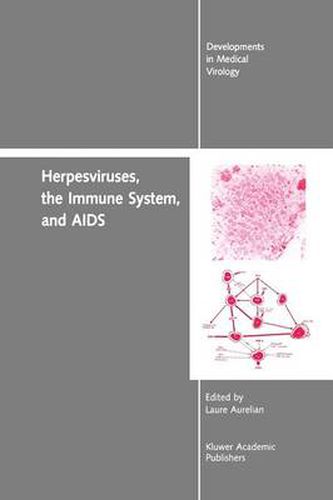Readings Newsletter
Become a Readings Member to make your shopping experience even easier.
Sign in or sign up for free!
You’re not far away from qualifying for FREE standard shipping within Australia
You’ve qualified for FREE standard shipping within Australia
The cart is loading…






This title is printed to order. This book may have been self-published. If so, we cannot guarantee the quality of the content. In the main most books will have gone through the editing process however some may not. We therefore suggest that you be aware of this before ordering this book. If in doubt check either the author or publisher’s details as we are unable to accept any returns unless they are faulty. Please contact us if you have any questions.
Shortly after the reeognition of the aequired immunodefieieney syndrome (AIDS) in 1981 (1-3), it was hypothesized that herpesviruses may play an important role in the etiology or pathogenesis of this newly identified syndrome (4,5). This theory was based on the faet that infeetion with herpesviruses was a prominent elinieal feature in nearly all patients with AIDS (3-5). Chronie mueocutaneous herpes simplex virus (HSV) infections were one of the first opportunistie infeetions deseribed in patients with AIDS (3), and both cytomegalovirus (CMV) and HSV infections were extremely common in individuals identified to be at highest risk for aequiring AIDS, such as homosexual men, intravenous drug users and hemophiliaes (4-8). CMVand Epstein-Barr virus (EBV) were also prominent infeetions whieh were suspected as possible etiologic agents of the prolonged fever, wasting, and Iymphadenopathy that often precedes AIDS, frequently referred to as the chronie Iymphadenopathy syndrome (9,10). Subsequent elinieal studies have indeed demonstrated that infeetions with HSV, CMV, EBV, and even varieella- zoster virus (VZV) are frequent opportunistic infeetions wh ich oeeur among AIDS patients (11-14). Several of the opportunistie infeetions caused by herpesviruses include encephalitis, chorioretinitis, hairy leukoplakia, esophagitis, enteritis, colitis, Burkitt’s lymphoma, primary CNS lymphoma, zoster, and there has even been speculation about the role of CMV in the pathogenesis of Kaposi’s sareoma (15,16). Furthermore, the herpesviruses, partieularly CMV and EBV have been known to be strongly associated with immunosuppression, partieularly of cell-mediated immune functions, which further supported the hypothesis that herpesviruses may contribute to the immune defects that eharacterize AIDS.
$9.00 standard shipping within Australia
FREE standard shipping within Australia for orders over $100.00
Express & International shipping calculated at checkout
This title is printed to order. This book may have been self-published. If so, we cannot guarantee the quality of the content. In the main most books will have gone through the editing process however some may not. We therefore suggest that you be aware of this before ordering this book. If in doubt check either the author or publisher’s details as we are unable to accept any returns unless they are faulty. Please contact us if you have any questions.
Shortly after the reeognition of the aequired immunodefieieney syndrome (AIDS) in 1981 (1-3), it was hypothesized that herpesviruses may play an important role in the etiology or pathogenesis of this newly identified syndrome (4,5). This theory was based on the faet that infeetion with herpesviruses was a prominent elinieal feature in nearly all patients with AIDS (3-5). Chronie mueocutaneous herpes simplex virus (HSV) infections were one of the first opportunistie infeetions deseribed in patients with AIDS (3), and both cytomegalovirus (CMV) and HSV infections were extremely common in individuals identified to be at highest risk for aequiring AIDS, such as homosexual men, intravenous drug users and hemophiliaes (4-8). CMVand Epstein-Barr virus (EBV) were also prominent infeetions whieh were suspected as possible etiologic agents of the prolonged fever, wasting, and Iymphadenopathy that often precedes AIDS, frequently referred to as the chronie Iymphadenopathy syndrome (9,10). Subsequent elinieal studies have indeed demonstrated that infeetions with HSV, CMV, EBV, and even varieella- zoster virus (VZV) are frequent opportunistic infeetions wh ich oeeur among AIDS patients (11-14). Several of the opportunistie infeetions caused by herpesviruses include encephalitis, chorioretinitis, hairy leukoplakia, esophagitis, enteritis, colitis, Burkitt’s lymphoma, primary CNS lymphoma, zoster, and there has even been speculation about the role of CMV in the pathogenesis of Kaposi’s sareoma (15,16). Furthermore, the herpesviruses, partieularly CMV and EBV have been known to be strongly associated with immunosuppression, partieularly of cell-mediated immune functions, which further supported the hypothesis that herpesviruses may contribute to the immune defects that eharacterize AIDS.